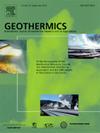Geodynamic correlation between the Hainan plume and the heat flow along the Southeast Coast of China: Numerical simulation
IF 3.9
2区 工程技术
Q3 ENERGY & FUELS
引用次数: 0
Abstract
The relationship between surface heat flow, geothermal resources, and the mantle plume has always been a hot topic in geothermics. Based on the latest heat flow data analysis, we find that away from the Hainan plume, the heat flow demonstrates an increasing trend toward the northeast, and the southeast China coast is a high heat flow belt. Additionally, there is a thin crustal belt that coincides with the high heat flow belt along the southeast China coast, along which a series of mantle plume-derived basalts have developed, and the age of these basalts gradually increases as away from the Hainan plume. To explain the correlation between the Hainan plume and the heat flow along the southeast China coast, we propose a dynamic model to simulate the thermal evolution process of the South China Block as it moved above the Hainan plume since 80 Ma. The modeling results show that a lithospheric high-temperature zone began to be formed in Fujian Province when it was located above the Hainan plume at 80 Ma. Subsequently, the South China Block moved to the northeast at a rate of 1.8 cm/year, and the lithospheric high-temperature zone was also gradually away from the Hainan plume, resulting in the current heat flow showing an increasing trend from Hainan Province to Fujian Province. Our results provide a novel explanation for the correlation between the Hainan plume and the heat flow along the southeast China coast, which might shed light on exploring geothermal resources along the southeast China coast.
海南羽流与中国东南沿海热流的地球动力学相关性:数值模拟
地表热流、地热资源与地幔柱之间的关系一直是地学研究的热点问题。根据最新的热流数据分析发现,远离海南羽流,东北方向的热流呈增加趋势,东南沿海为高热流带。此外,东南沿海有一条与高热流带重合的薄地壳带,沿此地壳带发育了一系列地幔柱衍生玄武岩,这些玄武岩的年龄随着远离海南地幔柱而逐渐增大。为了解释海南地幔柱与东南沿海热流的相关性,我们提出了一个模拟80 Ma以来华南地块在海南地幔柱上方运动的热演化过程的动力学模型。模拟结果表明,福建省在80 Ma时位于海南地幔柱上方,开始形成岩石圈高温带。随后,华南地块以1.8 cm/年的速度向东北移动,岩石圈高温区也逐渐远离海南地幔柱,导致当前热流呈现从海南向福建增加的趋势。研究结果为海南地幔柱与东南沿海热流的相关性提供了新的解释,为东南沿海地热资源的开发提供了新的思路。
本文章由计算机程序翻译,如有差异,请以英文原文为准。
求助全文
约1分钟内获得全文
求助全文
来源期刊

Geothermics
工程技术-地球科学综合
CiteScore
7.70
自引率
15.40%
发文量
237
审稿时长
4.5 months
期刊介绍:
Geothermics is an international journal devoted to the research and development of geothermal energy. The International Board of Editors of Geothermics, which comprises specialists in the various aspects of geothermal resources, exploration and development, guarantees the balanced, comprehensive view of scientific and technological developments in this promising energy field.
It promulgates the state of the art and science of geothermal energy, its exploration and exploitation through a regular exchange of information from all parts of the world. The journal publishes articles dealing with the theory, exploration techniques and all aspects of the utilization of geothermal resources. Geothermics serves as the scientific house, or exchange medium, through which the growing community of geothermal specialists can provide and receive information.
 求助内容:
求助内容: 应助结果提醒方式:
应助结果提醒方式:


